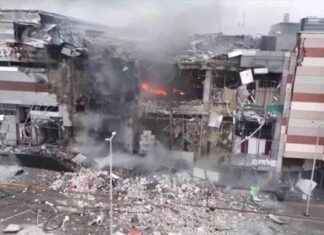He was a police recruit who is sharpshooting in “The Untouchables”, rose to the top Corleone crime family in the “The Godfather III”, and faced off against Brad Pitt, George Clooney and Matt Damon “Ocean’s Eleven.”
Andy Garcia, Oscar nominated actor, is now playing the role of Billy, a Cuban exile in the remake of “Father of the Bride,” that premieres on Thursday on HBO Max.
It is a privilege for him to be part the film’s remake with a distinct Latino flavor. This reminds him of the Miami Beach families with which he grew up.
Garcia said that he describes his character Billy as having a sense of needing accomplishment, honoring the sacrifices made by your parents, and taking pride in those achievements. “Like he said in the movie, time and again: ‘I arrived here. I slept on the Tio Walter’s flooring. I parked cars. I was a student. I was an architect. I built my house.”
In 1950, Spencer Tracy, a two-time Oscar-winning actor, released the original “Father of the Bride”. Steve Martin, a comedian and winner of five Grammys as well as one Prime-time Emmy in the role of father, was able to reprise the role in 1991. Both versions focus on the father-daughter relationship.
Now, 72 years later, the “Father of the Bride” film tells the story through Garcia’s eyes. Garcia is a Cuban American father who will be the father of Sofia (Adria Ajona), and her Mexican fiancé Adan (Diego Boneta).
However, this remake also examines the relationship between Garcia (Gloria Estefan), and Ines (Gloria Estefan), as they attempt to rekindle their relationship — while planning Sofia’s wedding.
Matt Lopez, the Latino remake of Father of the Bride’s screenplay, says he wanted to tell a story of love across multiple generations.
“The [wedding] band calls everyone up and you can sort of see love at all its stages, from couples who have been together for 30 years to people who met at the rehearsal dinner the night prior. He said that he had an idea about love throughout the years.
The movie includes elements of Latino life through its music and food, including the Cuban meal at beginning — with arroz and frijoles (rice and beans), papas rellenas (“potatoes filled in Caribbean-seasoned beef), and the traditional bolero (or danzon), a slow Latino dance performed during the father/daughter dance.
Lopez claims that the idea to open the movie with the wedding of the bride’s parents was his own. Garcia and Estefan are actually about to announce their separation when Estefan’s daughter surprises them by revealing that she is getting married.
The screenwriter asked the question: Can the parents of the bride rediscover their spark while putting together their daughter’s wedding?
The movie, like the previous “Father of the Bride,” uses humor to illustrate the generational differences between children and parents. Garcia fights with the young couple about everything, from who will pay for the ceremony to whether they will have a Catholic one.
The generational differences between the men, Billy and his son-in-law, are also evident in the way they see their careers as compared to the lives of the women around them.
“There is a beautiful scene in the film when Andy (Garcia), speaks to the young man who is going to marry his daughter. Diego Boneta plays Diego very well. Diego’s character is putting his career on hold or giving up to Sofia, his future bride, to give her the chance to follow her passion. It’s kinda this eye-opening moment Andy,” Lopez said. Lopez is culturally Cuban American.
It also contradicts his self-made, hardened philosophy of working nonstop. He said that sometimes family is better served than work.
Lopez created “Promised Land”, a television series about a successful California Latino winemaking clan. He said that it portrayed the tensions faced by many immigrant families as they try to preserve their culture and integrate into American society.
He also describes the extended Latino family in Father of the Bride as an intriguing crossroads that will intrigue many viewers.
It’s in their immigrant history, no matter how many generations back. You are both different and you come. You blend in. He said that he believes the closeness of these families is partly due to the fact that it’s your anchor, your space. It’s a bit of a safety net, if I may, as you move through the process of adapting to a wider culture.
Garcia claims that Billy, his character, is traditional and cut from a different cloth from his daughter’s generation. He also represents the values of 1960s exiles from Cuba who brought with them the perspectives and perspectives of their parents.
He said, “There’s a sense about exile. At least, the Cuban exile experience. You feel like no matter what you do in America, you have to keep working hard and saving America. And keep working hard because one day they’re gonna take everything from us.” That’s part and parcel of the psychological war wound. Billy is part of that generation.”
Garcia says that Billy is a political exile, who arrived in the United States as an individual, just like the thousands of young Cubans who arrived via Operation Pedro Pan. It was run by Catholic Charities, with assistance from the U.S government, and it is believed to have seen the largest exodus of unaccompanied kids from any country to the U.S. in 1962 to 1964, approximately 14,000.
Garcia claims that he immigrated from Cuba to Florida when he was just 5 years old. The assimilation process was difficult because he had to learn English. The actor loved America as a child and wanted to be able to express that love in his characters.
He said, “If it weren’t for the courage and exile my parents went into,” he added. “And this movie wouldn’t exist, and certainly it wouldn’t exist with me. That’s the truth. This is why I do not take it lightly.”
Follow NBC Latino via Facebook, Twitter, and Instagram








